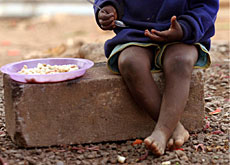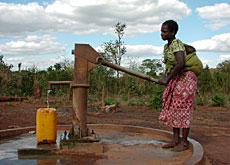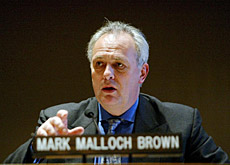Cosmetic changes lift Swiss aid spending

Switzerland's governmental aid agency says a significant increase last year in its development assistance was due mainly to debt relief measures.
Spending rose from 0.41 per cent of Gross National Product in 2004 to 0.44 per cent last year. Also included in the accounting for the first time was the price of second-hand military goods donated on humanitarian grounds.
In 2005, Switzerland spent SFr2.2 billion ($1.7 billion) on Official Development Assistance (ODA), according to the Swiss Agency for Development and Cooperation (SDC).
The SDC said the figure was presented by the Swiss government to the Development Assistance Committee of the Organisation for Economic Cooperation and Development (OECD).
The SDC put the increase down to measures to provide debt relief for Iraq, Nigeria and Congo, totalling SFr278.5 million.
In recent years, Swiss development aid has averaged 0.37 per cent of GNP, a level criticised by the United Nations and OECD as being far too low.
The government pledged to increase it to at least 0.4 per cent, and last year’s president, Samuel Schmid, announced at the UN millennium summit in September, that Switzerland was now spending 0.41 per cent.
Asylum costs
However, the figure was reached by adding costs related to asylum requests, a manoeuvre denounced by non-governmental organisations.
Expenditure on asylum seekers has been included in Switzerland’s ODA since 2004.
The SDC also said the price of disused army goods shipped to poor countries was included in the 2005 figures, each vehicle or piece of equipment valued at half its original purchase price.
This amounted to an additional SFr23 million.
Contributions for “peace initiatives” were much higher last year, largely due to the fact that the foreign ministry took over some of the funding for international security centres in Geneva from the defence ministry.
Without the inclusion of the debt relief measures, Switzerland’s contribution to aid would have been 0.38 per cent of GNP – well below the government target.
The UN has called on countries to raise spending to 0.56 per cent of GNP by 2010 and to 0.7 per cent by 2015 to combat global poverty.
Last year, the OECD said Switzerland should increase the amount of its aid to 0.7 per cent and reduce the number of recipient countries.
The majority of European Union member states have committed themselves to raise contributions to 0.7 per cent of GNP by 2015, and four have already achieved that target.
swissinfo with agencies
According to the OECD, Switzerland was the world’s 13th largest donor in 2004, and 8th when looked at as a percentage of GNP.
The Swiss Agency for Development and Cooperation (SDC) is a department within the foreign ministry.
Its 2005 budget was SFr1.3 billion. It offers direct aid to developing countries, and supports programmes of multilateral organisations as well as financing projects by Swiss and international aid agencies.
It focuses on three areas: bilateral and multilateral development cooperation, humanitarian aid and cooperation with countries in eastern Europe.

In compliance with the JTI standards
More: SWI swissinfo.ch certified by the Journalism Trust Initiative












You can find an overview of ongoing debates with our journalists here . Please join us!
If you want to start a conversation about a topic raised in this article or want to report factual errors, email us at english@swissinfo.ch.